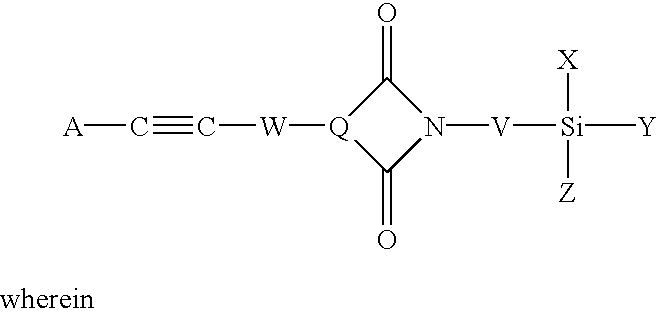Phenylethynyl-containing imide silanes
a technology of imide silane and phenylethynyl, which is applied in the direction of organic chemistry, group 3/13 element organic compounds, adhesive processes with surface pretreatment, etc., can solve the problems of premature cleavage of alkoxy groups, hygroscopic, and low long-term hydrolytic stability
- Summary
- Abstract
- Description
- Claims
- Application Information
AI Technical Summary
Benefits of technology
Problems solved by technology
Method used
Image
Examples
example 2
Synthesis of .gamma.-[N-(4-phenylethynylphthalimido)]propyltriethoxysilane (APEIS-2)
[0119] 21
[0120] To a flame dried 3 necked 3 L round bottom flask equipped with nitrogen inlet, mechanical stirrer, and Dean-Stark trap was charged 1250 mL of toluene. .gamma.-Aminopropyltriethoxysilane (266.3 g, 1.2029 mol) was then added via a syringe under the toluene surface. Prior to use 4-phenylethynylphthalic anhydride was recrystallized from toluene. 4-Phenylethynylphthalic anhydride (298.6 g, 1.2029 mol) was added to the stirred solution and washed in with an additional 250 mL of toluene. Approximately 4 mL of pyridine was subsequently added to the stirred solution. The stirred solution was heated at a mild reflux for 48 hrs under a nitrogen atmosphere. The solution was subsequently cooled to room temperature and the toluene removed under vacuum to afford 464.1 g (85%) of a viscous brown gum. No melting point was observed as determined by differential scanning calorimetry at a heating rate of...
example 3
Synthesis of N-(4-phenylethynylphthalamide acid)-3(4)-phenyltrimethoxysila-ne (APEAAS-1)
[0121] 22
[0122] Into a flame dried 250 mL three necked round bottom flask equipped with nitrogen inlet, mechanical stirrer, and drying tube were placed 4-phenylethynylphthalic anhydride (25.6433 g, 0.1033 mol) and 50 mL of N-methyl-2-pyrrolidinone (NMP). Prior to use 4-phenylethynylphthalic anhydride was recrystallized from toluene. The solution was cooled to approximately 10.degree. C. by means of an ice bath. Then aminophenyltrimethoxysilane (22.0349 g, 0.1033 mol) was added and washed in with 20 mL of NMP to afford a 39.74% (w / w) solution. The reaction was allowed to warm to room temperature with stirring and stirred at room temperature for 24 hours under nitrogen.
Controlled Molecular Weight Pendent Phenylethynyl Amide Acid Oligomers Terminated with Substituted Silanes
example 4
(Ratio of 0.85:0.15) 77.29 mole % 3,4'-Oxydianiline and 13.64 mole % 3,5-Diamino-4'-phenylethynylbenzophenone, and 3,3',4,4'-Biphenyltetracarb-oxylic Dianhydride, Using 9.07 Mole % Stoichiometric Offset and 18.15 Mole % Aminophenyltrimethoxysilane, (Calculated {overscore (M)}.sub.n=5000 g / Mole) (PPEIDS-1)
[0123] The following example illustrates the reaction sequence in Eqn. 3 for the preparation of the controlled molecular weight PPEIDS where Ar' is equal to a diphenylene where X is an oxygen atom located in the 3,4'-position and Z is equal to a benzoyl group located in the 4-position and Ar is equal to a bis(o-diphenylene) where Y is a nil group located in the 4,4'-position, where R' is equal to a phenylene group located in the 3 and 4 positions at a ratio of 85:15, where R is equal to a methyl group, and where n is zero. The ratio of diamines [Ar':R] is 0.85:0.15. The stoichiometric imbalance is 9.07 mole % and the endcapping agent is 18.15 mole % of aminophenyltrimethoxysilane wi...
PUM
| Property | Measurement | Unit |
|---|---|---|
| temperature | aaaaa | aaaaa |
| lap shear strengths | aaaaa | aaaaa |
| lap shear strengths | aaaaa | aaaaa |
Abstract
Description
Claims
Application Information
 Login to View More
Login to View More - R&D
- Intellectual Property
- Life Sciences
- Materials
- Tech Scout
- Unparalleled Data Quality
- Higher Quality Content
- 60% Fewer Hallucinations
Browse by: Latest US Patents, China's latest patents, Technical Efficacy Thesaurus, Application Domain, Technology Topic, Popular Technical Reports.
© 2025 PatSnap. All rights reserved.Legal|Privacy policy|Modern Slavery Act Transparency Statement|Sitemap|About US| Contact US: help@patsnap.com



